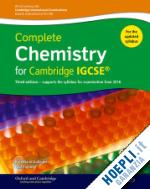1.1 - Everything is made of particles
1.2 - Solids, liquids, and gases
1.3 - The particles in solids, liquids, and gases
1.4 - A closer Look at gases
2.1 - Mixtures, solutions, and solvents
2.2 - Pure substances and impurities
2.3 - Separation methods (part I)
2.4 - Separation methods (part II)
2.5 - More about paper chromatography
3.1 - Atoms and elements
3.2 - More about atoms
3.3 - Isotopes and radioactivity
3.4 - How electrons are arranged
3.5 - The metals and non-metals
4.1 - Compounds, mixtures, and chemical change
4.2 - Why do atoms form bonds?
4.3 - The ionic bond
4.4 - More about ions
4.5 - The covalent bond
4.6 - Covalent compounds
4.7 - Comparing ionic and covalent compounds
4.8 - Giant covalent structures
4.9 - The bonding in metals
5.1 - The names and formulae of compounds
5.2 - Equations for chemical reactions
5.3 - The masses of atoms, molecules, and tons
5.4 - Some calculations about masses and %
6.1 - The mole
6.2 - Calculations from equations, using the mole
6.3 - Reactions involving gases
6.4 - The concentration of a solution
6.5 - Finding the empirical formula
6.6 - From empirical to final formula
6.7 - Finding % yield and % purity
7.1 - Oxidation and reduction
7.2 - Redox and electron transfer
7.3 - Redox and changes in oxidation state
7.4 - Oxidising and reducing agents
8.1 - Conductors and insulators
8.2 - The principles of electrolysis
8.3 - The reactions at the electrodes
8.4 - The electrolysis of brine
8.5 - Two more uses of electrolysis
9.1 - Energy changes in reactions
9.2 - Explaining energy changes
9.3 - Energy from fuels
9.4 - Giving out energy as electricity
9.5 - Reversible reactions
9.6 - Shifting the equilibrium
10.1 - Rates of reaction
10.2 - Measuring the rate of a reaction
10.3 - Changing the rate of a reaction (part I)
10.4 - Changing the rate of a reaction (part II)
10.5 - Explaining rates
10.6 - Catalysts
10.7 - Photochemical reactions
11.1 - Acids and alkalis
11.2 - A closer look at acids and alkalis
11.3 - The reactions of acids and bases
11.4 - A closer look at neutralisation
11.5 - Oxides
11.6 - Making salts
11.7 - Making insoluble salts by precipitation
11.8 - Finding concentrations by titration
12.1 - An overview of the Periodic Table
12.2 - Group I: the alkali metals
12.3 - Group VII: the halogens
12.4 - Group VIII: the noble gases
12.5 - The transition elements
12.6 - Across the Periodic Table
13.1 - Metals: a review
13.2 - Comparing metals for reactivity
13.3 - Metals in competition
13.4 - The reactivity series
13.5 - Making use of the reactivity series
14.1 - Metals in the Earth's crust
14.2 - Extracting metals from their ores
14.3 - Extracting iron
14.4 - Extracting aluminium
14.5 - Making use of metals and alloys
14.6 - Steels and steel-making
15.1 - What is air?
15.2 - Making use of air
15.3 - Pollution alert!
15.4 - The rusting problem
15.5 - Water supply
16.1 - Hydrogen, nitrogen, and ammonia
16.2 - Making ammonia in industry
16.3 - Fertilisers
16.4 - Sulfur and sulfur dioxide
16.5 - Sulfuric acid
16.6 - Carbon and the carbon cycle
16.7 - Some carbon compounds
16.8 - Greenhouse gases, and global warming
16.9 - Limestone
17.1 - Petroleum: a fossil fuel
17.2 - Refining petroleum
17.3 - Cracking hydrocarbons
17.4 - Families of organic compounds
17.5 - The alkanes
17.6 - The alkenes
17.7 - The alcohols
17.8 - The carboxylic acids
18.1 - Introducing polymers
18.2 - Addition polymerisation
18.3 - Condensation polymerisation
18.4 - Making use of synthetic polymers
18.5 - Plastics: here to stay?
18.6 - Natural polymers in food (part I)
18.7 - Natural polymers in food (part II)
19.1 - Chemistry: a practical subject
19.2 - Example of an experiment
19.3 - Working with gases in the lab
19.4 - Testing for ions in the Lab: cations
19.5 - Testing for ions in the lab: anions












